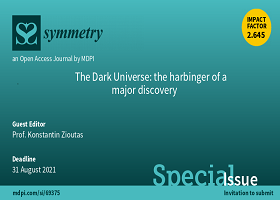The Dark Universe: The Harbinger of a Major Discovery
A special issue of Symmetry (ISSN 2073-8994). This special issue belongs to the section "Physics".
Deadline for manuscript submissions: 30 April 2024 | Viewed by 9403

Special Issue Editor
Special Issue Information
The nature of the dark universe, we are living in, remains elusive since decades. For example, the origin of dark matter, dark energy, and the matter-antimatter asymmetry in the cosmos are the most tantalizing challenges for all of physics. It is actually unusual that fundamental physics questions remain unanswered for several decades. Novel ideas going beyond standard techniques might bring the breakthrough(s) in the exciting field of astroparticle physics. The level of the issue allows to address a wide audience of scientists also beyond physics. This might trigger a synergy towards novel interdisciplinary solutions within overlooked anomalous findings, e.g., from atmospheric physics to exoplanetary systems including lasting mysteries in biomedicine. Also, all this might be the overlooked manifestation of the dark universe and they may unravel the nature of the dark universe. Primarily, this issue is of pedagogical nature aiming to show young researchers that also in our time there is no lack of novel ideas.
Prof. Konstantin Zioutas
Guest Editor
Manuscript Submission Information
Manuscripts should be submitted online at www.mdpi.com by registering and logging in to this website. Once you are registered, click here to go to the submission form. Manuscripts can be submitted until the deadline. All submissions that pass pre-check are peer-reviewed. Accepted papers will be published continuously in the journal (as soon as accepted) and will be listed together on the special issue website. Research articles, review articles as well as short communications are invited. For planned papers, a title and short abstract (about 100 words) can be sent to the Editorial Office for announcement on this website.
Submitted manuscripts should not have been published previously, nor be under consideration for publication elsewhere (except conference proceedings papers). All manuscripts are thoroughly refereed through a single-blind peer-review process. A guide for authors and other relevant information for submission of manuscripts is available on the Instructions for Authors page. Symmetry is an international peer-reviewed open access monthly journal published by MDPI.
Please visit the Instructions for Authors page before submitting a manuscript. The Article Processing Charge (APC) for publication in this open access journal is 2400 CHF (Swiss Francs). Submitted papers should be well formatted and use good English. Authors may use MDPI's English editing service prior to publication or during author revisions.
Keywords
- Dark matter;
- Dark energy;
- Dark matter streams;
- Cosmic rays;
- Matter antimatter asymmetry;
- Cosmology; Models;
- Dark Universe;
- Symmetry;
- axion;
- WIMP;
- Beyond SM physics;
- Direct dark matter signatures;
- Astrophysical dark matter signatures;
- Detection techniques;
- Cosmological constant;
- Variable physics constants;
- Gravitation;
Planned Papers
The below list represents only planned manuscripts. Some of these manuscripts have not been received by the Editorial Office yet. Papers submitted to MDPI journals are subject to peer-review.
Title: Cosmic fluxes of multiple charge constituents of composite dark matter and their effects
Authors: M.Yu.Khlopov* et al
Affiliation: * NRNU MEPHI, Moscow; SFEDU, Rostov on Don, Russia and APC Laboratory, Paris, France
Abstract: The lack of positive signatures of supersymmetric particles at the LHC can imply non supersymmetric solutions for the problems of divergence of Higgs boson mass and origin of the electroweak symmetry breaking scale.
The models of composite Higgs boson can solve these problems and give rise to stable -2n charged lepton-like particles.
These particles bound with n nuclei of primordial helium form dark atoms of dark matter.
Dark atom hypothesis can explain the puzzles of direct dark matter searches and is challenging for studies of signatures of multiple charged stable particles. Destruction of dark atoms by high energy cosmic rays or in Supernova explosions should lead to existence of cosmic fluxes of stable multiple charged particles and we discuss possible
features and effects of this exotic component of cosmic rays.
Title: Dark antimatter: new features of mirror world
Authors: zurab berezhiani
Affiliation: full professor of theoretical physics at the Department of Physical and Chemical Sciences, University of L'Aquila L'Aquila, Italy
scientific Staff member at
INFN, Gran Sasso National Laboratories, Assergi, Italy
Abstract: Dark matter in the Universe can exist in the form of matter of a parallel mirror sector of particles identical to that of ordinary particles. In the Early Universe, B and L violating interactions between the particles of ordinary and mirror worlds can co-generate their baryon asymmetries in comparable amounts, Ω′B ≥ ΩB, also predicting the sign of mirror baryon asymmetry. At low energies, the same interactions induce particle mixing phenomena between two sectors. In this way, e.g. mirror neutron n′ should oscillate into our antineutron n ̄, with probability that depends on environmental conditions as matter density and magnetic fields. This oscillation can be faster than the neutron decay itself, with n′−n ̄ conversion rate accessible for the experimental search.
In short, the possibility of dark matter conversion into our antimatter which can have fascinating phenomenological and astrophysical consequences, and can open a potentially huge source of energy by getting an antimatter from mirror matter in a controllable way.





